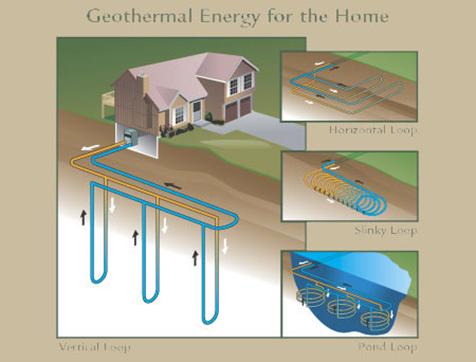
|
Geothermal slinky loop systems can be used in a ground loop, pond loop, or lake loop design and uses the earth as a heat source and heat sink. A series of pipes, commonly called a loop, carry a fluid used to connect the geothermal system's heat pump to the earth. There are different types of geothermal loops, a open loop or a closed loop. A slinky loop is a closed loop system. A slinky loop is utilizing the same fluid in a closed loop circuit made of pipe or tubing. Once used it is released back into the loop system where the energy is transferred and then recycled to be used again. |
|
Slinky Loop |
|
Geothermal heating and cooling does not rely on the outside temperature. The outdoor air temperatures fluctuate and change with the seasons, but the underground temperatures remain virtually the same as do water temperatures. Depending on your geographic location , four to six feet below the earth’s surface the temperatures remain around 56 degrees. Geothermal systems, which typically consist of an indoor unit and a buried or submersed loop, using the earth’s constant temperature to provide “free” energy. |
|
The slinky ground loop is a key part of the geothermal system and it must be properly designed and installed. The plans to the loop ground field are easy to understand but applying the technology to the design is quite complicated. Careful design is necessary to ensure that there is sufficient capacity available for the geothermal heat pump to operate properly. Design consideration is crucial when spacing the pipes in a loop and is important as this affects how much the heating or cooling effect of one pipe influences the heat source or heat sink available to adjacent pipes. |
|
Closed loop designed systems are becoming the most common type of geothermal source. Closed loops utilize polyethylene piping buried into the ground or submersed into a lake or pond, filled with a fluid mixture of water/anti-freeze solution. The loop fluid circulating in this closed piping (Closed Circuit) system absorbs heat or rejects heat into the surrounding earth.
Taking an inventory of all available resources both man made and natural will help in deciding what type of Geothermal Design loop system is most efficient for the geographic location of installation. |
|
Closed loops are virtually maintenance free, and since they re-circulate the same fluid there is no water to discharge. However, closed loops in a ground design , due to the excavation costs, are generally more expensive than a lake or pond slinky loop system. |

|
Slinky Loops |
|
Slinky horizontal coil loops are latest in ground loop design. The overlapping coils made of polyethylene pipe are used to increase the heat exchange, but requires more pipe per ton of capacity. For ground installation, a two-pipe systems may require 200 to 300 feet of trench per ton of nominal heat exchange capacity. The trench length decreases as the number of pipes in the trench increases or as Slinky coil overlapping increases. This same slinky coil design-system can be used in a lake or pond application. |
|
The slinky water loop geothermal system can be installed into a lake or pond and it must be properly designed and installed. The plans to the slinky loop pond or lake are easy to understand but applying the technology to the design is quite complicated. Careful design is necessary to ensure that there is sufficient capacity available for the geothermal heat pump to operate properly. Design consideration is crucial when submersing the pipes is important as this affects how much the heating or cooling effect of one pipe influences the heat source or heat sink available to adjacent pipes. |
|
Need help? Call:
(512) 704-8200
(229) 638-2889
Submit Question Email Us:
info@geothermalsolutions.net |